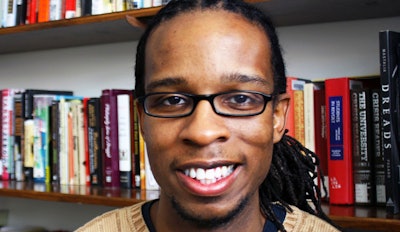 Ibram X. Kendi
Ibram X. KendiI dreaded reading it. It took me almost a week to finally comb through the U.S. Supreme Court Justice Clarence Thomas’s concurring opinion in Fisher v. University of Texas at Austin. Four days may not seem like much time to you. But for someone like me who is so passionate about educational justice, it seemed like an eternity.
I thought the 20-page opinion would leave me outraged. And why torture yourself when you do not have to. Then again, I have to. It was a must read for me, and it should be a must read for anyone who is passionate about educational justice, anyone studying race and education, anyone striving to diversify (or homogenize) our academy.
His words did not torture me. I did not get up from my computer fuming. I got up from my computer thinking, disagreeing, even agreeing.
I must admit I concur with some points in Justice Thomas’s opinion, points of agreement I examine in part two of this blog. I am happy he had the courage to say them, and I hope they start a national dialogue. But then there are more serious claims that warrant historical, logical, and factual clarification, which I sketch here.
Justice Thomas agreed with the majority to send the case back to the lower courts for another strict review. But he was ready to overrule Grutter v. Bollinger (2003), and explains his reasoning in his separate 20-page opinion.
Justice Thomas declares emphatically that “the educational benefits flowing from student body diversity” do not qualify as a compelling state interest. Indeed, he says, “the argument that educational benefits justify racial discrimination was advanced in support of racial segregation in the 1950’s, but emphatically rejected by this Court. And just as the alleged educational benefits of segregation were insufficient to justify racial discrimination then, see Brown v. Board of Education, 347 U. S. 483 (1954), the alleged educational benefits of diversity cannot justify racial discrimination today.”
Justice Thomas outlines three arguments posed “by the University today” that are “virtually identical” to the arguments the Court rejected ages ago “in our desegregation cases.” The University of Texas and segregationists both claimed their policies prepare students to become leaders, improves interracial relations, and although not ideal, are necessary to address lingering racial bigotry. “The University’s arguments today are no more persuasive than they were 60 years ago,” Justice Thomas said. “There is no principled distinction between the University’s assertion that diversity yields education benefits and the segregationists’ assertion that segregation yielded those same benefits.”
On the face of it, Justice Thomas has a point. The arguments are eerily similar. But I am shocked that of all people, Thomas, a native of segregated Georgia, would draw this analogy. And more appallingly, spend the rest of his opinion questioning the sincerity of Texas’s arguments, while never questioning the honesty of the segregationist arguments.
Does he really believe segregationists cared about creating meaningful leadership opportunities for Blacks? Does he really believe segregationists cared about improving race relations? Does he really believe segregationists did not view segregation as the ideal racial picture? Does he really believe that the University of Texas is being less sincere than the segregationists? Does he really believe that separate was, or was ever meant, to be equal? Is he really that out of touch with reality?
Justice Thomas is either being blatantly dishonest, or his taking these segregationist arguments as truth demonstrates his blatant inability to decipher, to assess and to judge. It is the job of judges, or juries, to separate truth from lies. He must know they are lies, but is shamefully disregarding reality—what undermines his analogy.
Like many Americans, Justice Thomas seems either oblivious or refuses to see reality that strategy racists are discriminating against people who look like him. The strategy emerged in the late 1960s as a defense against race-specific initiatives to level the racial playing field.
In my first book, I named the strategy “egalitarian exclusion.” It is the prohibition or limiting of nonwhites, nonwhite authority, or race-specific initiatives using derivatives of equality, race-neutrality, or ‘reverse’ discrimination as justifications. In the case of affirmative action, the challenge has been waged in the name of equality. It is a flowered-covered attempt to secure more seats for white students, who racists know benefit from the so-called race neutral admissions criteria and a deeply unequal K-12 system. Standardized tests, access to college prep courses, grade point average, and the other major admissions factors are not race neutral.
The major strategic difference between 2013 and 1913 is the public rhetorical use of race. When segregationists were instituting measures to eliminate or reduce the number of Black college students, they had no problem saying so in public. Today, they would never say so in public. The verbal means has changed. But the discriminatory end remains the same. In the name of killing racial discrimination in higher education, Justice Thomas—knowingly or unknowingly—is sustaining its life.
It took the U.S. Supreme Court almost a century to outlaw the prevailing practice of racial discrimination. It took the Court almost a century to legally realize that the separate but equal mantra was a strategy to racially discriminate. How long will it take for the Supreme Court this time to outlaw the prevailing practice of racial discrimination? How long will it take the Court to legally realize the race-neutral mantra is nothing but a cold-blooded strategy to racially discriminate? How long will Justice Clarence Thomas run away from reality?
Dr. Ibram X. Kendi (formerly Ibram H. Rogers) is an assistant professor of Africana studies at University at Albany — SUNY. He is the author of The Black Campus Movement: Black Students and the Racial Reconstitution of Higher Education, 1965-1972. Follow on Twitter at @DrIbram















